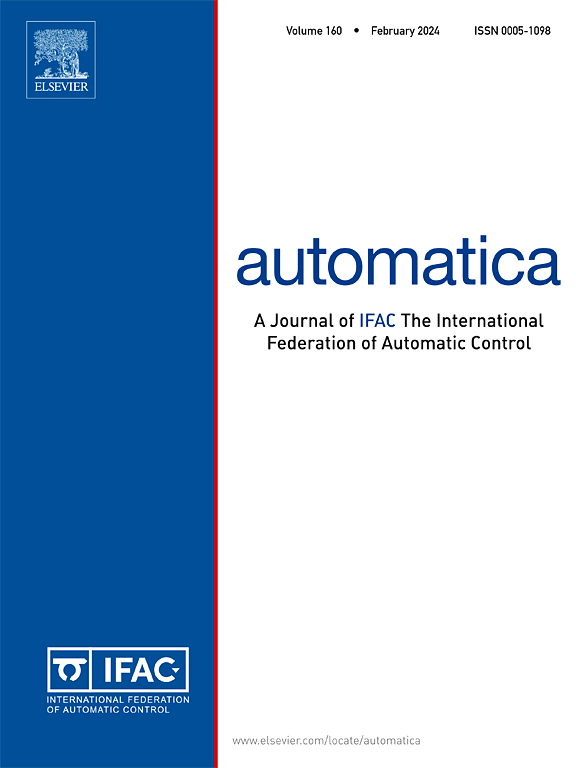Robust optimal lane-changing control for Connected Autonomous Vehicles in mixed traffic
IF 5.9
2区 计算机科学
Q1 AUTOMATION & CONTROL SYSTEMS
引用次数: 0
Abstract
We derive time and energy-optimal policies for a Connected Autonomous Vehicle (CAV) to execute lane change maneuvers in mixed traffic, i.e., in the presence of both CAVs and Human Driven Vehicles (HDVs). These policies are also shown to be robust with respect to the unpredictable behavior of HDVs by exploiting CAV cooperation which can eliminate or greatly reduce the interaction between CAVs and HDVs. We derive a simple threshold-based criterion on the initial relative distance between two cooperating CAVs based on which an optimal policy is selected such that the lane-changing CAV merges ahead of a cooperating CAV in the target lane; in this case, the lane-changing CAV’s trajectory becomes independent of HDV behavior. Otherwise, the interaction between CAVs and neighboring HDVs is formulated as a bilevel optimization problem with an appropriate behavioral model for an HDV, and an iterated best response (IBR) method is used to determine an equilibrium. We demonstrate the convergence of the IBR process under certain conditions. Furthermore, Control Barrier Functions (CBFs) are implemented to ensure the robustness of lane-changing behaviors by guaranteeing safety in both longitudinal and lateral directions despite HDV disturbances. Simulation results validate the effectiveness of our CAV controllers in terms of cost, safety guarantees, and limited disruption to traffic flow. Additionally, we demonstrate the robustness of the lane-changing behaviors in the presence of uncontrollable HDVs.
混合交通中互联自动驾驶汽车的鲁棒最优变道控制
我们推导了在混合交通中,即在CAV和人类驾驶车辆(HDVs)同时存在的情况下,联网自动驾驶汽车(CAV)执行变道机动的时间和能量最优策略。这些策略通过利用CAV合作来消除或大大减少CAV和hdv之间的相互作用,对于hdv的不可预测行为也显示出鲁棒性。在此基础上选择最优策略,使变道自动驾驶汽车在目标车道内先于合作自动驾驶汽车合并;在这种情况下,变道CAV的轨迹变得独立于HDV的行为。另外,将自动驾驶汽车与相邻自动驾驶汽车之间的相互作用表述为具有合适的自动驾驶汽车行为模型的双层优化问题,并使用迭代最佳响应(IBR)方法确定平衡点。我们证明了在一定条件下IBR过程的收敛性。此外,控制障碍函数(cbf)通过保证纵向和横向的安全来确保变道行为的鲁棒性,尽管HDV干扰。仿真结果验证了我们的CAV控制器在成本、安全保证和对交通流的有限干扰方面的有效性。此外,我们证明了在不可控的hdv存在下变道行为的鲁棒性。
本文章由计算机程序翻译,如有差异,请以英文原文为准。
求助全文
约1分钟内获得全文
求助全文
来源期刊

Automatica
工程技术-工程:电子与电气
CiteScore
10.70
自引率
7.80%
发文量
617
审稿时长
5 months
期刊介绍:
Automatica is a leading archival publication in the field of systems and control. The field encompasses today a broad set of areas and topics, and is thriving not only within itself but also in terms of its impact on other fields, such as communications, computers, biology, energy and economics. Since its inception in 1963, Automatica has kept abreast with the evolution of the field over the years, and has emerged as a leading publication driving the trends in the field.
After being founded in 1963, Automatica became a journal of the International Federation of Automatic Control (IFAC) in 1969. It features a characteristic blend of theoretical and applied papers of archival, lasting value, reporting cutting edge research results by authors across the globe. It features articles in distinct categories, including regular, brief and survey papers, technical communiqués, correspondence items, as well as reviews on published books of interest to the readership. It occasionally publishes special issues on emerging new topics or established mature topics of interest to a broad audience.
Automatica solicits original high-quality contributions in all the categories listed above, and in all areas of systems and control interpreted in a broad sense and evolving constantly. They may be submitted directly to a subject editor or to the Editor-in-Chief if not sure about the subject area. Editorial procedures in place assure careful, fair, and prompt handling of all submitted articles. Accepted papers appear in the journal in the shortest time feasible given production time constraints.
 求助内容:
求助内容: 应助结果提醒方式:
应助结果提醒方式:


